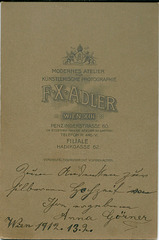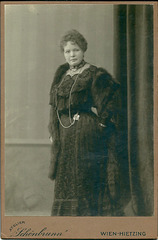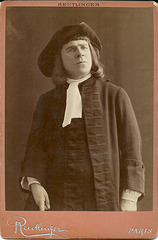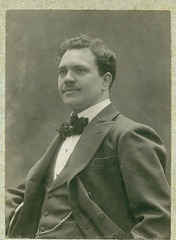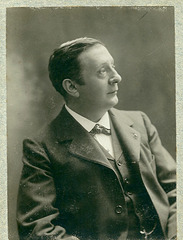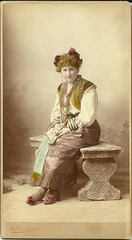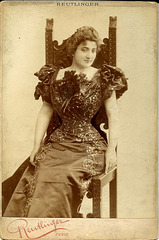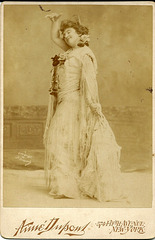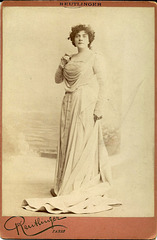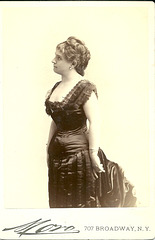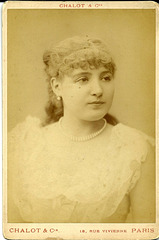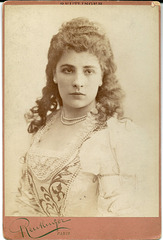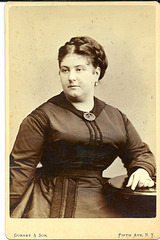
19TH CENTURY OPERA SINGERS
Anna Semmler-Gorner Autograph
Anna Semmler-Gorner by Schonbrunn
| |
|
ANNA SEMMLER - GORNER
Soprano performed Vienna
No details known CAN YOU HELP
Married to Mr Gorner
David Bispham by Reutlinger
| |
|
Thanks to Walther van Rooij of Netherlands for his help on identifying
DAVID SCULL BISPHAM
(January 5, 1857 – October 2, 1921)
American Baritone
Studied singing in Florence with Luigi Vannuccini and in Milan with Francesco Lamperti. He also studied in Bayreuth. Royal Opera at Covent Garden to sing the part of Beckmesser in Wagner's Die Meistersinger von Nürnberg in June 1892 , Kurwenal in Richard Wagner's Tristan und Isolde.
American debut, once again in Wagner, at the Metropolitan Opera in New York City on November 18, 1896; that night he sang the role of Sixtus Beckmesser in Die Meistersinger von Nürnberg.In 1901 he gave a recital exclusively featuring songs of of Carrie Jacobs-Bond in Chicago's Studebaker Theatre, After 1903 Bispham's operatic appearances were few, and he devoted most of his time to recitals, with which he had much success
Mounet-Sully by Van Bosch
| |
|
Mounet-Sully as Hamlet
Mounet-Sully (February 28, 1841 – 1916), a French actor, was born at Bergerac. His birth name was Jean-Sully Mounet: "Mounet-Sully" (without the "Jean") was a stage name.
Adolphe Marechal by Berger
| |
|
ADOLPHE MARECHAL
(26 September 1867 – 1 February 1935) Belgian tenor
born Liège. Having studied at the Liège Conservatoire, Maréchal made his debut at Dijon in 1891 and toured the French provinces, singing in Rheims, Nice, Bordeaux, and especially at the Théâtre du Grand Cercle in Aix-les-Bains.
He was engaged by the Opéra-Comique in 1895, making his debut as Don José in Carmen on 7 October 1895. His repertoire at the Opéra-Comique covered Cavalleria Rusticana (Turrido), Don Juan (Ottavio), Les dragons de Villars (Sylvain), Joseph, Lakmé (Gérald), Manon (des Grieux), Mireille (Vincent), La Navarraise (Araquil), Le pardon de Ploërmel (Un faucheur), Les pêcheurs de perles (Nadir), Le pré aux clercs (Mergy) and Le roi d'Ys (Mylio).[4] He also sang in several premieres, notably Louise in 1900 (Julien) and Grisélidis in 1901 (Alain), as well as enjoying a success in the Paris premiere of La Boheme (Rodolphe).
At the Opéra de Monte-Carlo he created the role of Jean in Le jongleur de Notre Dame in 1902, and made his debut at Covent Garden the same year as Don José, also appearing in Faust, Manon and the première of The Princess Osra by Herbert Bunning (1863-1937)
He retired back to Belgium in 1907,
Gabriel Valentin Soulacroix by Berger
| |
|
GABRIEL VALENTIN SOULACROIX
(11 December 1853 , Villeneuve-sur-Lot – 16 August 1905, Paris)
French operatic baritone.
He studied at Toulouse, where he won four first prizes, and then in Paris
Making his debut in Mireille on 5 September 1878, Soulacroix appeared regularly at La Monnaie, Brussels, including in some local operatic premieres.
His repertoire in Brussels included Le timbre d'argent by Camille Saint-Saëns (10 February 1879, playing the doctor), L'orage, an opéra-comique by Jean Urich (2 May 1879, Julien), The magic flute in French, (January to April 1880, Papageno), La Bernoise, an opéra comique by Emile Mathieu (1 April 1880, André), Le capitaine Raymond, an opéra comique by Jean-Baptiste Colyns (8 April 1881, Le comte de Guitaut), Jean de Nivelle by Léo Delibes (28 November 1882, Le comte de Charolais), Le panache blanc, an opéra comique by Philippe Flon (15 February 1884), Manon (15 March 1884, Lescaut), Le trésor, an opéra-comique by Charles Edouard Lefebvre (15 December 1884, Le duc Jean), Joli Gilles by Ferdinand Poise (7 February 1885, title role), and The Mastersingers of Nuremberg in French (7 March 1885, Sixtus Beckmesser).
Soulacroix joined the Opéra-Comique company in 1885, his first appearance being as Bellamy in Les dragons de Villars on 25 September 1885. He sang Ford in the 1894 production of Falstaff, as well as Alfio (Cavalleria rusticana), Ourrias (Mireille), Schaunard (La Boheme) and Figaro (The Barber of Seville). He was on-stage singing Laerte in Mignon the night of the fire at the Salle Favart on 25 May 1887, and later received a médaille de sauvetage. In December 1899 he added Oreste to his repertoire, in a production of Iphigénie en Tauride at the Théâtre de la Renaissance.
At the Covent Garden in London he sang the roles of Pedrillo, Escamillo, Figaro (Rossini), Alfio, Mercutio and Beckmesser. In addition, he was seen in a wide range of parts regularly at Monte Carlo from 1889 to 1904, including the title role in Zampa and Iago in Otello. His career was ended prematurely by his sudden death in middle-age.
Laura Hilgermann by Karoly
| |
|
Laura Hilgermann as Carmen 'Carmen" Bizet
LAURA HILGERMANN-RADO
(Laura Oberlander )
(Vienna Währing, 13 10, 1865; – Budapest (?), 1943)
Soprano
(From 1887 was known as Laura Hilgermann)
Her voice was discovered by an operetta singer and Karl Maria Wolf and Siegfried Rosenberg (whom she married) in Vienna formed. In 1885 she made her debut at the Deutsches Theater in Prague as Azucena in 'Troubadour'. Until 1889, it remained at this house, which she left in 1889 after a dispute with the director Angelo Neumann. Then they sang 1890-1900 at the National Opera Budapest. She was appointed in 1900 by Gustav Mahler at the Vienna Court Opera, whose member she remained until 1920 (with a break in the season 1902-03) was, and where it still has performed well after 1920. In Vienna became the artist whose repertoire included both alto and soprano parts, great popularity. In 1920 she was made an honorary member of the Vienna State Opera. In 1900 she sang in a memorable new production of 'Così fan tutte' by Gustav Mahler in Vienna Dorabella. Your very multifaceted repertoire included among others the Sieglinde in the 'Valkyrie', the Mignon, Carmen,Amneris in 'Aida', Cherubino as the Countess, in 'Marriage of Figaro', the Idamantes in 'Idomeneo' and the Orpheus of Gluck this also lots in the then modern operas of Janác | vek, Schreker, Bittner and Korngold. She sang after a subsequent marriage under the name Laura Hilger man-Radó. After completion of her career she was a sought vocal teacher in Budapest and 1920-36 there professor at the Franz Liszt Academy of Music; among their students of Maria Nemeth, Gitta Alpar, Enid Szantho and Mary Ilosvay. She died during the siege of Budapest by the Russian army in the basement of her destroyed house
Minnie Hauk by Frey (5)
| |
|
MINNIE HAUK
(Amalia Mignon Hauck)
(November 16, 1851 – February 6, 1929),
American Soprano.
In 1862, Hauk began vocal studies with Achille Errani, who secured her a spot with the operatic company of Max Maretzek. At age fourteen she made her debut in Brooklyn as Amina in La sonnambula, and a month later, in November, 1866, her New York City debut as Prascovia in L'étoile du nord. In the American premiere of Gounod's Roméo et Juliette (1867) she sang Juliette. Hauk sang at Covent Garden, London, on 26 October 1868, and debuted in Paris in 1869. The soprano then appeared in Italian and German opera at the Grand Opera in Vienna and other venues throughout Europe. Hauk was the first American Carmen (1878) and Manon (1885). Her voice became a mezzo-soprano of great strength and depth. Hauk's enormous repertory included approximately one hundred roles, and she sang Carmen in four languages.
Emma Calve by Reutlinger
| |
|
EMMA CALVE
(Rosa Emma Calvet de Noëmie Roquer)
(August 15, 1858 – January 6, 1942), French Soprano
Her operatic debut occurred on September 23, 1881, in Gounod's Faust at Brussels' La Monnaie. Later she sang at La Scala in Milan, and also at the principal theatres of Naples, Rome, and Florence.
Returning to Paris in 1891, she created the part of Suzel in L'amico Fritz by Pietro Mascagni, playing and singing the role later at Rome. Because of her great success in it, she was chosen to appear[citation needed] as Santuzza in the French premiere of Cavalleria rusticana, which was viewed as one of her greatest parts. She repeated her success in it in London.
Her next triumph was Bizet's Carmen. Before beginning the study of this part, she went to Spain, learned the Spanish dances, mingled with the people and patterned her characterization after the cigarette girls whom she watched at their work and at play. In 1894, she made her appearance in the role at the Opéra-Comique, Paris. The city's opera-goers immediately hailed her as the greatest Carmen that had ever appeared, a verdict other cities would later echo. She had had many famous predecessors in the role, including Adelina Patti, Minnie Hauk and Célestine Galli-Marié, but critics and musicians agreed that in Calvé they had found their ideal of Bizet's cigarette girl of Seville.
Calvé first appeared in America in the season of 1893–1894 as Mignon. She would make regular visits to the country, both in grand opera and in concert tours. After making her Metropolitan Opera debut as Santuzza, she went on to appear a total of 261 times with the company between 1893 and 1904. She created the part of Anita, which was written for her, in Massenet's La Navarraise in London in 1894 and sang Sapho in an opera written by the same composer.
She sang Ophélie in Ambroise Thomas's Hamlet in Paris in 1899, but the part was not suited to her and she dropped it. She appeared with success in many roles, among them, as the Countess in The Marriage of Figaro, the title role in Félicien David's Lalla-Rookh, as Pamina in The Magic Flute, and as Camille in Hérold's Zampa, but she is best known as Carmen
.
Emma Calve by Aime Dupont
| |
|
Emma Calve as Carmen 'Carmen" Bizet
EMMA CALVE
(Rosa Emma Calvet de Noëmie Roquer)
(August 15, 1858 – January 6, 1942), French Soprano
Her operatic debut occurred on September 23, 1881, in Gounod's Faust at Brussels' La Monnaie. Later she sang at La Scala in Milan, and also at the principal theatres of Naples, Rome, and Florence.
Returning to Paris in 1891, she created the part of Suzel in L'amico Fritz by Pietro Mascagni, playing and singing the role later at Rome. Because of her great success in it, she was chosen to appear as Santuzza in the French premiere of Cavalleria rusticana, which was viewed as one of her greatest parts. She repeated her success in it in London.
Her next triumph was Bizet's Carmen. Before beginning the study of this part, she went to Spain, learned the Spanish dances, mingled with the people and patterned her characterization after the cigarette girls whom she watched at their work and at play. In 1894, she made her appearance in the role at the Opéra-Comique, Paris. The city's opera-goers immediately hailed her as the greatest Carmen that had ever appeared, a verdict other cities would later echo. She had had many famous predecessors in the role, including Adelina Patti, Minnie Hauk and Célestine Galli-Marié, but critics and musicians agreed that in Calvé they had found their ideal of Bizet's cigarette girl of Seville.
Calvé first appeared in America in the season of 1893–1894 as Mignon. She would make regular visits to the country, both in grand opera and in concert tours. After making her Metropolitan Opera debut as Santuzza, she went on to appear a total of 261 times with the company between 1893 and 1904. She created the part of Anita, which was written for her, in Massenet's La Navarraise in London in 1894 and sang Sapho in an opera written by the same composer.
She sang Ophélie in Ambroise Thomas's Hamlet in Paris in 1899, but the part was not suited to her and she dropped it. She appeared with success in many roles, among them, as the Countess in The Marriage of Figaro, the title role in Félicien David's Lalla-Rookh, as Pamina in The Magic Flute, and as Camille in Hérold's Zampa, but she is best known as Carmen
.
Etelka Gerster by Mora
| |
|
|
ETELKA GERSTER
(25 June 1855, Košice – 20 August 1920, Pontecchio)
Hungarian Soprano
Studied on the recommendation of the composer Hellmesberger at the Vienna Conservatory at the famous Mathilde Marchesi de Castrone. The composer Verdi heard her in 1875 in the house of her teacher at the presentation of an aria from his opera 'La Traviata' and recommended it to the Teatro Fenice Venice. There she began her great career in 1876, by Gilda in 'Rigoletto' as recited debut role. 1876-77 had her first successes in Marseille and Genoa. 1877 she was staying with an Italian opera company in Berlin, her sister, the soprano Bertha Krause-Gerster (* 1852? April 1885 Paris), was a member at the Kroll Opera .. She married the impresario Carlo Gardini (1833-1910),In 1877 she came to London and was at Her Majesty's Theatre as Amina in Bellini's 'La Sonnambula and was' very successful, so came in the following years to Her Majesty's near the end of her career in 1890 she was at the Covent Garden Opera . In the years 1878-87 she was mainly in North America, and indeed after 1878, she sang at the Mapleson Opera Company with which they undertook extensive concert tours through the United States. In 1878 she toured with this company at the Academy of Music in New York and had in her inaugural role of Amina in 'La Sonnambula', and then the Queen of the Night in the Magic Flute . In 1889 she moved to Berlin and opened a singing school, which met with general approval, and where she taught until 1917 there. She was the teacher of Lula Mysz Gmeiner, Clara Butt and Julia Culp.. In 1918 she retired to her villa in Pontecchio near Bologna .
Meyriane Heglon by Reutlinger
| |
|
MEYRIANE HEGLON-LEROUX
(Bruxelles, 21 juin 1867 – 1942).
Belguim Contralto
Debut 05 November 1890 in RIGOLETTO (Madeleine). Sings SIGURD (Uta, 1890), William TELL (Edwige, 1891), AIDA (Amneris, 1891), SAMSON ET DALILA (Dalila, 1893), die WALKÜRE (Fricka, 1893), the mountain black (Yamina, 1895); THE taking of Troy (Cassandre), HAMLET (Queen), the song of departure in 1900; HENRY VIII (Anne), the Prophet (Fides) in 1903. Has created the life of the poet (the Muse), die WALKÜRE (Schwartleite); on March 16, 1894 (Myrtale) THAIS by Jules Massenet; DJELMA (Ourvaci), OTHELLO (Emilia), Black Mountain (Dara), FRÉDÉGONDE (Frédégonde), the Rhine (Liberal) Bell, the BURGUNDIAN (Pyrrha), ASTARTE (Omphale), barbarians (Livia), SIEGFRIED (Erda), ORSOLA (Orsola), the son of the Star (Lilith) and THEODORA (Theodora).
Rosa Bosman by Benque
| |
|
Rosa Bosman as Rafaela 'Patrie" Paladilhe
ROSA BOSMAN
(Bruxelles, 29 décembre 1857 – 1930).
Belguim Soprano
She studied singing at the Brussels Conservatory in the class of Henri Warnots. Her debut at la Monnaie in Brussels in CARMEN (Carmen) in 1880. She debuted at the Opera June 12, 1885 by attending the first of SIGURD (Hilda) of Ernest Reyer. Creates the CID (Infante) November 30, 1885, MOTHERLAND! (Rafaela), LA DAME DE MONSOREAU (Diane), ASCANIO (Scozzone), STRATONICE (Stratonice), LANCELOT (Elaine), April 26, 1901 the King of PARIS (Jeanne de Noirmoutiers) of Georges Hüe. She attended the first hearing of the Rhine gold (Fricka, Wellegunde) by Richard Wagner 06 May 1893. On the other hand, has been shown successively from 1885 to 1898 in GUILLAUME TELL (Mathilde), LE CID (Chimène), FAUST (Marguerite), SIGURD (Jennifer), DON JUAN (Zerlina, and Doña Elvira), the Prophet (Berthe) L'AFRICAINE (Ines), LA JUIVE (Eudokia), ROBERT LE DIABLE (Alice), the MAGE (Anahita), LOHENGRIN (Elsa), SALAMMBÔ (Salammbô), die WALKÜRE (Sieglinde), OTHELLO (Desdemona), TANNHÄUSER (Elisabeth), DJELMA (Djelma) and the master SINGERS of NUREMBERG (Eva).
Anna De Bellocca by Mora
| |
|
ANNA DE BELOCCA
(née de Bellokh) (4 January 1854 – unknown ), was a Russian-born operatic contralto.
born in St.Petersburg, Studied with Lablache and Maurice Strakosch, she made her stage debut in Paris at the Théâtre Italien as Rosina The Barber of Seville. She also appeared there in the title role of La Cenerentola and as Arsace in Semiramide. She appeared in various cities in Europe, including Councilor of State. After studying in St. Petersburg with Henriette Nissen-Saloman and in Paris with Nicolas London, where she made her debut with Mapleson's company. She then became a member of the Strakosch Opera Company with whom she made her American debut on 17 April 1876 as Rosina at New York's Academy of Music. She also appeared in concerts in Boston, Chicago, Philadelphia and San Francisco. With the Mapleson company, she continued to sing leading roles in New York and Philadelphia through the 1880s.
Mirielle Berthon by Chalot
| |
|
MIRIELLE BERTHON
(Paris, 06 August 1889 – 16 January 1955).
French Soprano
Debut THAÏS (Thaïs) January 07, 1917. The same year, sang FAUST (Marguerite), ROMEO and Juliet (Juliet), RIGOLETTO (Gilda), MAZARIN VIRTUOZI, ROMA (Junia), then is displayed in CASTOR and POLLUX (Phoebe, 1918), fatherland! (Rafaela, 1919), LA DAMNATION DE FAUST (Marguerite, 1919), die WALKÜRE (Guerhilde, 1921), ANTAR (Abia, 1921) gold of the Rhine (Freia, 1921), LOHENGRIN (Elsa, 1922), HERODIAS (Salome, 1923), ZAUBERFLÖTE (Pamina, 1923), the garden of Paradise (Arabella, 1923), PARSIFAL (girl-flower, 1924), ESTHER (Esther, 1925) and bench (Nedda, 1927).
Marguerite Carrere-Xanrof by Reutlinger
| |
|
MARGUERITE CARRERE-XANROF
(Marie Héloïse SOUVIROU-CARRÈRE)
(Bordeaux, 13 September 1867-1952).
French Soprano
Debut June 24, 1892 in FAUST (Marguerite). Sang LES HUGUENOTS (the Queen, 1892, Urbain, 1897), LA JUIVE (Eudokia, 1892), ROBERT LE DIABLE (Isabelle, 1892), the Prophet (Berthe, 1892), ROMEO and Juliet (Juliet, 1893; Stefano, 1901), die WALKÜRE (Sieglinde, 1894; Helmwigue, 1895), TANNHÄUSER (Venus, 1895), DON JUAN (Zerline, 1897), MESSIDOR (Helen, 1897), BRISEIS (Briseis, 1899), JOSEPH (Benjamin, 1899), THAIS (Thais, 1901), ASTARTE (Iole, 1901). Participated in the premiere of die WALKÜRE (Guerhilde
Euphrosyne Parepa-Rosa by Gurney
| |
|
EUPHROSYNE PAREPA-ROSA
(7 May 1836 – 21 January 1874)
British Soprano
Her operatic début was at the age of 16 in Malta as Amina in La Sonnambula, followed by engagements in Naples, Genoa, Rome, Florence, Madrid, and Lisbon. She sang at the Lyceum Theatre, London, for the 1857 season (the year after the Royal Opera House in Covent Garden burnt down), and between 1859 and 1865 appeared in opera at both Covent Garden and Her Majesty's Theatre. During this time, she participated in two operatic premieres, creating the title role in Alfred Mellon's Victorine on 19 December 1859, and the role of Mabel in George Alexander Macfarren's opera Helvellyn on 5 November 1864.
Established the Parepa-Rosa English Opera Company there, In 1870, the Parepa-Rosa Opera Company returned to Britain and then appeared in Italian opera at Cairo, Egypt, followed by a return to America for another successful tour in 1871-71. In 1872, they returned to Britain. In September 1873, the company changed its name to Carl Rosa's English Opera, since Parepa was pregnant Parepa-Rosa died in childbirth in London at the age of 37 while preparing a production of an English version of Richard Wagner's Lohengrin.
Zina Brozia by Cheri-Rousseau & Glauth
| |
|
Zina Brozia as Thais "Thais" Massenet
ZINA BROZIA
1880-
French Soprano
Studied with Elena Teodorini in Paris . Her Opera Comique debut was as Violetta “La Traviata” by Verdi on the 13 September 1905, after singing the roles of Gilda, Manon and Seso in the world première of Erlanger’s “Aphrodita”, She was a member of the Opéra Comique between 1905-1909. In 1907 she sang at Monte Carlo, making her debut as Elena in Mefistofele, and thereafter appearing as Elisabeth in Verdi’ s Don Carlos. She made guest appearances at the Monnaie, Brussels, and in 1908 at the Teatro Regio, Parma, as Butterfly and Manon. She débuted at the Palais Garnier on 27 March 1908 as Gilda in Rigoletto and also sang Juliet “Romeo and Juliet “ , Marguerite “Faust”, Marguerite “ Mefistofele”, Thais “Thais” then, in 1909, in Ophelia “Hamlet”. In 1911 Russell brought her to Boston and from Boston she returned to France. In 1914 at Théâtre de Gaité à Paris she sang Salome in Massenet’s Herodiade and took part in Bianchini’s Radda , a one act piece after a drama by Gorki. Also she created Hirschmann's “La Danseuse de Tangra” at La Gaitie in Paris.
Jump to top
RSS feed- Latest items - Subscribe to the latest items added to this album
- ipernity © 2007-2024
- Help & Contact
|
Club news
|
About ipernity
|
History |
ipernity Club & Prices |
Guide of good conduct
Donate | Group guidelines | Privacy policy | Terms of use | Statutes | In memoria -
Facebook
Twitter

